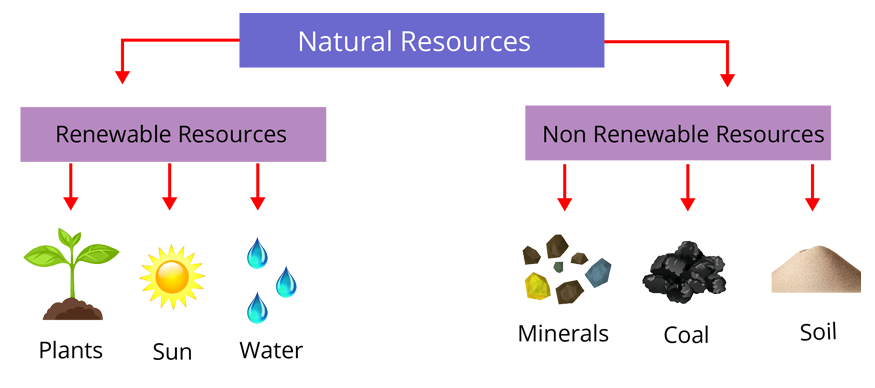What are The Resources of Earth?
Earth is unique among the planets in our solar system because it offers everything we need to survive, such as water, air, and food. But what are the resources of Earth? They include a wide range of elements like minerals, fossil fuels, forests, and sources of energy that help us live comfortably. They can be broadly divided into those obtained directly from nature (like water and sunlight) and those that require human intervention (like refined petroleum products).
In simple terms, resources on Earth support life in every possible way. Our existence depends on how wisely we use these resources so that future generations can also benefit from them.
What are Natural Resources?
Natural resources are substances and materials that exist in nature without human effort. Examples include water, sunlight, wind, soil, plants, and animals. These resources form the basis of life on Earth because they help fulfil our fundamental needs – for instance, soil helps grow food, and water is vital for drinking and irrigation.

Types of Natural Resources
Have you ever wondered what are the 4 types of natural resources? While we often classify them into just two categories—renewable and non-renewable—some experts group them into four broader types:
Actual Resources: Those that are surveyed, quantified, and currently in use (e.g., active coal mines or operating oil wells).
Potential Resources: Those that exist but are not yet fully used or explored (e.g., tidal energy in certain coastal areas).
Renewable Resources: Resources that can be replenished relatively quickly by natural processes.
Non-renewable Resources: Resources available in limited quantities that cannot be replaced easily once they are exhausted.
Renewable Resources
These are resources that nature can restore or replenish over time. Examples include sunlight, wind, fresh water (through the water cycle), and biomass (like wood from forests). Because they can be regenerated, they are considered more sustainable for long-term use.
Non-renewable Resources
These resources either take millions of years to form or exist in fixed amounts. Fossil fuels (coal, petroleum, and natural gas) and minerals (iron, gold, and diamonds) fall into this category. Once used, it is extremely difficult or impossible to replace them within a human lifespan.
What are 20 Natural Resources?
Water
Air
Sunlight
Wind
Soil
Coal
Petroleum (Crude Oil)
Natural Gas
Forests (Timber)
Wildlife (Fauna)
Agricultural Crops
Marine Life (Fish)
Salt
Iron Ore
Copper Ore
Gold
Silver
Sand
Clay
Geothermal Energy
All these examples are found naturally on our planet, though some require human effort to make them usable.
What are the 10 Important Natural Resources?
Freshwater (Drinking and Irrigation)
Clean Air (Respiration and Health)
Soil (Agriculture and Habitat)
Forests (Timber, Habitat, Oxygen Production)
Fossil Fuels (Energy Production)
Sunlight (Solar Energy)
Wind (Wind Energy)
Minerals (Construction and Manufacturing)
Marine Resources (Food and Trade Routes)
Biodiversity (Genetic Variety and Ecosystem Balance)
Each of these resources plays a pivotal role in supporting life and various economic activities worldwide.
Importance of Natural Resources
Natural resources are crucial for several reasons:
Sustaining Life: They supply essential elements like oxygen (through plants), water, and nutrients for plants and animals.
Economic Development: Many industries—such as construction, agriculture, and manufacturing—depend on raw materials derived from natural resources.
Energy Generation: Resources like coal, petroleum, natural gas, sunlight, and wind are used to produce energy.
Environmental Balance: Forests and other ecosystems maintain oxygen and carbon dioxide levels, support biodiversity, and regulate climate.
Future Security: Wise use of resources ensures that future generations can also meet their own needs.
Depletion of Resources on Earth
Sadly, human activities are leading to the rapid depletion of Earth’s resources. The major causes include:
Overpopulation: With more people, there is a higher demand for food, water, energy, and land.
Over-exploitation: Excessive harvesting of resources like fisheries, forests, and minerals depletes them quickly.
Deforestation: Clearing forests for agriculture and urban development disrupts ecosystems.
Loss of Biodiversity: Pollution and habitat loss lead to the extinction of various species.
Industrialisation: The rapid growth of industries consumes large amounts of fossil fuels and minerals.
Pollution: Land, water, and air pollution make resources unusable.
Erosion: Loss of fertile soil reduces agricultural productivity.
Tips to Conserve Resources
Use Renewable Energy: Switch to solar, wind, or hydro energy whenever possible.
Recycle and Reuse: Decrease the need to extract new raw materials by recycling paper, metals, and plastics.
Responsible Consumption: Limit waste, especially food and water.
Reforestation: Plant trees to combat deforestation and maintain ecological balance.
Sustainable Farming: Adopt eco-friendly agricultural methods to keep the soil fertile.
Public Awareness: Educate others about natural resources examples and why conservation matters.
Also refer:
These topics will further deepen your understanding of resource management and ecological balance.


FAQs on Resources on Earth: Types, Examples and Conservation
1. What is the main reason to save natural resources?
We must save natural resources to ensure that future generations can also have access to clean air, water, energy sources, and food supplies. Conservation helps maintain the balance of the ecosystem and prevents the depletion of important materials.
2. How do renewable and non-renewable resources differ?
Renewable resources, such as wind and sunlight, can be replenished naturally at a pace that matches their usage. Non-renewable resources like coal and petroleum take millions of years to form and can run out if used excessively.
3. Can overpopulation affect resource availability?
Yes, overpopulation increases demand for essential items like food, water, and energy. This leads to faster consumption of resources and puts stress on the environment.
4. Why is biodiversity considered a vital resource?
Biodiversity ensures the stability of ecosystems by providing a variety of species that each play a role in food chains and nutrient cycles. Losing biodiversity can disrupt these processes, affecting the availability of many resources.
5. What are the benefits of using renewable energy?
Renewable energy sources produce little to no greenhouse gases, reducing pollution and helping conserve non-renewable resources. They are more sustainable and often cost-effective in the long run.










